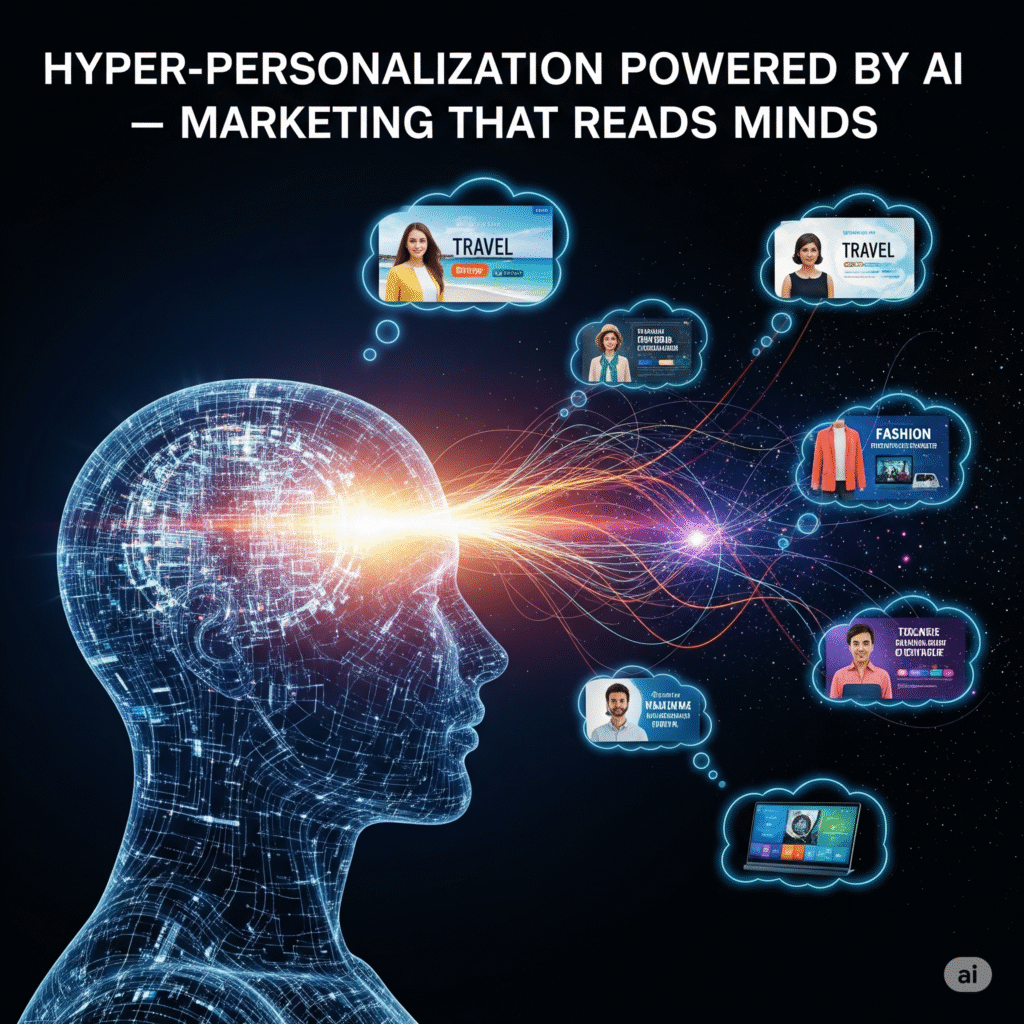Keywords: Hyper-personalization, AI-powered marketing, AI in customer experience, predictive marketing, personalization engines, real-time customer targeting, AI recommendation systems, customer journey optimization, personalized advertising, marketing automation with AI
Introduction — The Age of AI That Knows You Better Than You Know Yourself
In the past, marketing meant guessing what customers wanted based on demographics and generic trends. Today, AI-powered hyper-personalization is changing the game. It’s no longer about broad targeting—it’s about understanding each customer individually, predicting their needs, and delivering offers so tailored that it feels like the brand can read their mind.
Powered by massive datasets, machine learning algorithms, and real-time analytics, hyper-personalization is becoming the gold standard for businesses seeking to win loyalty in a crowded marketplace.

What is Hyper-Personalization?
Hyper-personalization is an advanced form of personalization that uses artificial intelligence (AI), predictive analytics, and real-time data to deliver highly relevant content, product recommendations, and experiences to individual customers.
Unlike traditional personalization—which might simply insert a customer’s first name into an email—AI-driven hyper-personalization considers:
- Browsing behavior
- Purchase history
- Location data
- Social media activity
- Real-time interactions
By combining these factors, brands can create dynamic, context-aware marketing experiences that feel like a one-on-one conversation.
How AI Powers Hyper-Personalization
Artificial Intelligence makes hyper-personalization faster, smarter, and more accurate. Here’s how:
1. Data Collection & Analysis
AI algorithms process billions of data points from CRM systems, websites, mobile apps, and social media to identify hidden patterns in customer behavior.
2. Predictive Analytics
Using historical and behavioral data, AI can predict what a customer is likely to buy next—before they even start looking.
3. Real-Time Decision Making
AI systems like recommendation engines and dynamic content tools update instantly to reflect user actions in real time.
4. Natural Language Processing (NLP)
NLP allows AI to understand customer intent from search queries, messages, or voice commands, helping brands respond with contextually relevant offers.
Real-World Examples of AI-Driven Hyper-Personalization
- Netflix & Streaming Platforms
- Uses AI to recommend shows and movies tailored to your viewing habits—sometimes even adjusting thumbnails to grab your attention.
- Amazon & E-Commerce
- Suggests products based on your browsing history, purchase patterns, and items bought by customers with similar profiles.
- Spotify & Music Apps
- Creates daily and weekly playlists based on listening history, moods, and even time of day.
- Retail Stores
- AI-powered apps send location-based offers when you’re near a physical store.
Benefits of Hyper-Personalization for Businesses
- Higher Conversion Rates — Customers are more likely to buy when they see relevant offers.
- Increased Customer Loyalty — Personalized experiences build trust and long-term engagement.
- Better ROI on Marketing Spend — AI ensures your marketing budget targets the right people at the right time.
- Reduced Churn — Anticipating customer needs keeps them from switching to competitors.
Why Customers Love Hyper-Personalization
While businesses benefit financially, customers gain:
- Time Savings — No need to sift through irrelevant offers.
- Better Experiences — Feels like the brand truly understands them.
- More Relevant Content — Increases satisfaction and enjoyment of the product/service.
The Role of Predictive Marketing in Hyper-Personalization
Predictive marketing is the engine behind mind-reading-like personalization. By analyzing past customer behavior, AI can predict future actions with surprising accuracy:
- Anticipating when a customer will reorder a product
- Identifying when they might switch to a competitor
- Recommending complementary products before they’re needed
This is why hyper-personalized campaigns outperform generic marketing by a huge margin.
Challenges and Risks of Hyper-Personalization
- Data Privacy Concerns
- Collecting personal data at this scale raises questions about transparency and consent.
- Regulations like GDPR and CCPA require careful compliance.
- Over-Personalization
- If marketing feels too predictive, customers might feel uncomfortable or “watched.”
- Bias in AI Algorithms
- If training data is biased, recommendations may unintentionally exclude or misrepresent certain groups.
Best Practices for Implementing AI-Powered Hyper-Personalization
- Be Transparent About Data Use
- Clearly explain what data is collected and how it benefits the customer.
- Use Multi-Channel Personalization
- Integrate personalization across email, mobile apps, websites, and in-store experiences.
- Test and Refine Continuously
- Use A/B testing to ensure recommendations actually improve engagement.
- Balance Automation with Human Insight
- AI can predict, but humans can ensure empathy and brand authenticity remain intact.
The Future — AI That Anticipates Needs Before You Have Them
We are moving toward a world where AI anticipates desires even before customers consciously realize them. For example:
- Smart fridges automatically placing grocery orders.
- Travel platforms suggesting vacation packages right when you need a break.
- Virtual AI shopping assistants building outfits based on upcoming events in your calendar.
This proactive AI will blur the line between marketing and service—making every interaction seamless and intuitive.
Conclusion
AI-powered hyper-personalization is redefining marketing from a mass-broadcast activity to a one-to-one, predictive engagement strategy. Brands that embrace this shift will build deeper customer relationships, higher loyalty, and stronger revenue growth.
However, success will depend on responsible AI use, transparent data practices, and ethical personalization. Done right, hyper-personalization won’t just “read minds”—it will earn trust while delighting customers.










